The Analytical Model of Stress Zone Formation of Ti6Al4V/AA1050/AA2519 Laminate Produced by Explosive Bonding
Abstract
1. Introduction
2. Materials and Methods
3. Results
3.1. Simulation of Deformation Top of the Plate by Finite Element Method
3.2. The Simplified Analytical Model of Deformation of the Top Part of Preparation
3.3. Research of Residual Pressure in a Lining by Means of the Finite Element Method (FEM)
4. Discussion
5. Conclusions
Author Contributions
Funding
Acknowledgments
Conflicts of Interest
References
- Kosturek, R.; Wachowski, M.; Sniezek, L.; Gloc, M.; Sobczak, U. The effects of the heat treatment on the microstructure of Inconel 625/steel bimetal joint obtained by explosive welding. In Proceedings of the International Conference on Advanced Functional Materials and Composites (ICAFMC2018), MATEC Web of Conferences 242, Barcelona, Spain, 5–7 September 2018. [Google Scholar] [CrossRef]
- Rozumek, D.; Marciniak, Z. Fatigue tests of bimetal zirconium-steel made by explosive welding. Procedia Eng. 2016, 160, 137–142. [Google Scholar] [CrossRef]
- Wachowski, M.; Gloc, M.; Slęzak, T.; Plocinski, T.; Kurzydlowski, K.J. The Effect of Heat Treatment on the Microstructure and Properties of Explosively Welded Titanium-Steel Plates. J. Mater. Eng. Perform. 2017, 26, 945–954. [Google Scholar] [CrossRef]
- Prazmowski, M.; Rozumek, D.; Paul, H. Static and fatigue tests of bimetal Zr-steel made by explosivewelding. Eng. Fail. Anal. 2017, 75, 71–81. [Google Scholar] [CrossRef]
- Rozumek, D.; Banski, R. Crack growth rate under cyclic bending in the explosively welded steel/titaniumbimetals. Mater. Des. 2012, 38, 139–146. [Google Scholar] [CrossRef]
- Дерибас, А.А.; Кудинoв, В.М.; Матвеенкoв, Ф.И.; Симoнoв, В.А. Сварка взрывoм. Физика гoрения и взрыва 1967, 1, 111–118. [Google Scholar]
- Manikandan, P.; Hokamoto, K.; Deribas, A.; Raghukandan, K.; Tomoshige, R. Explosive Welding of Titanium, Stainless Steel by Controlling Energetic Conditions. Mater. Trans. 2006, 47, 2049–2055. [Google Scholar] [CrossRef]
- Cowan, G.R.; Holtzman, A.H. Flow Configurations in Colliding Plates: Explosive Bonding. J. Appl. Phys. 1963, 34, 928–939. [Google Scholar] [CrossRef]
- Szecket, A.; Inal, O.T.; Vigueras, D.J.; Rocco, J. A wavy versus straight interface in the explosive welding of aluminum to steel. J. Vac. Sci. Technol. 1985, 3, 2588–2593. [Google Scholar] [CrossRef]
- Grignon, F.; Benson, D.; Vecchio, K.S.; Meyers, M.A. Explosive welding of aluminum to aluminum: Analysis, computations and experiments. Int. J. Impact. Eng. 2014, 30, 1333–1351. [Google Scholar] [CrossRef]
- Hutsaylyuk, V.; Sulym, H.; Turchyn, I.; Asternak, J. Dissipative Structures Modeling in the Aluminium Alloy: An Energy Approach. In Proceedings of the 8th International Conference on Intelligent Technologies in Logistics and Mechatronics Systems, Panevezys, Lithuania, 23 May 2013. [Google Scholar]
- Лысак, В.И.; Кузьмин, С.В. Развитие представлений o нижней границе сварки металлoв взрывoм. Автoматическая сварка 2009, 11, 7–14. [Google Scholar]
- Haddar, N.; Fissolo, A.; Maillot, V.; Haddar, N. Thermal fatigue crack networks: An computational study. Int. J. Sol. Struct. 2005, 42, 771–788. [Google Scholar] [CrossRef]
- Nishida, M.; Minakuchi, K.; Anado, K.; Araki, T.; Hyodo, K. Fabrication of high-strength steel fiber reinforced metal matrix composites by explosive bonding and their tensile properties. Weld. Int. 1995, 9, 179–184. [Google Scholar] [CrossRef]
- Szachogluchowicz, I.; Sniezek, L.; Hutsaylyuk, V. Low cycle fatigue properties of AA2519-Ti6Al4V laminate bonded by explosion welding. Eng. Fail. Anal. 2016, 69, 77–87. [Google Scholar] [CrossRef]
- Lysak, V.I.; Kuzmin, S.V. Explosive Welding of Metal Layered Composite Materials; Paton Electric Welding Institute of NASU: Kiev, Ukraine, 2003; p. 117. [Google Scholar]
- Pasternak, I.; Pasternak, R.; Sulym, H. Pasternak Ia. Boundary integral equations and Green’s functions for 2D thermoelectroelastic biomaterial. Eng. Anal. Bound. Elements 2014, 48, 87–101. [Google Scholar] [CrossRef]
- Paris, P.; Erdogan, F.A. Critical analysis of crack propagation laws. J. Basic Eng. 1963, 85, 528–534. [Google Scholar] [CrossRef]
- Sih, G.C. Mechanics of Fracture Initiation and Propagation: Surface and Volume Energy Density Applied as Failure Criterion; Institute of Fracture and Solid Mechanics Lehogh University: Bethlehem, PA, USA, 1991. [Google Scholar]

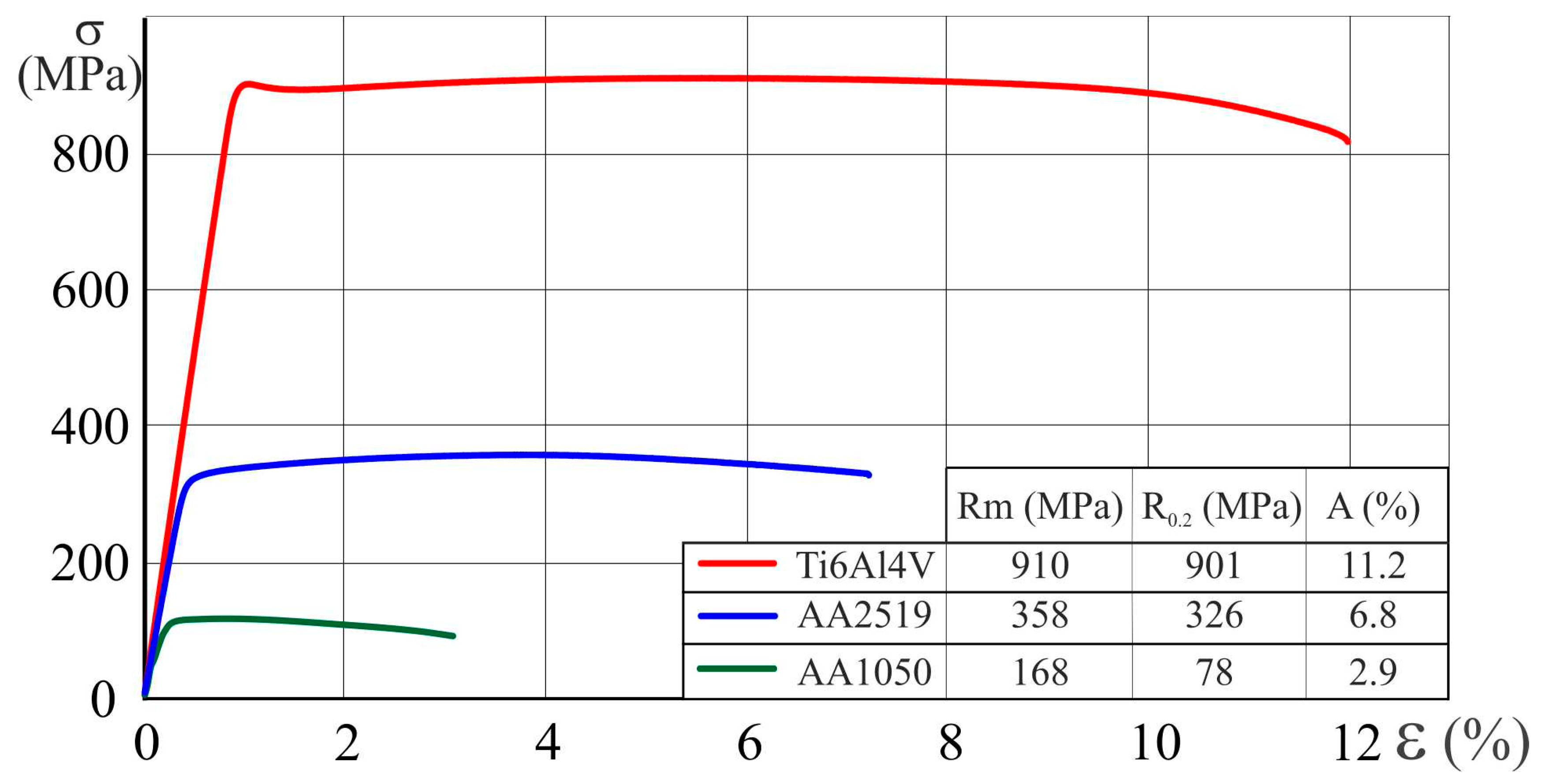
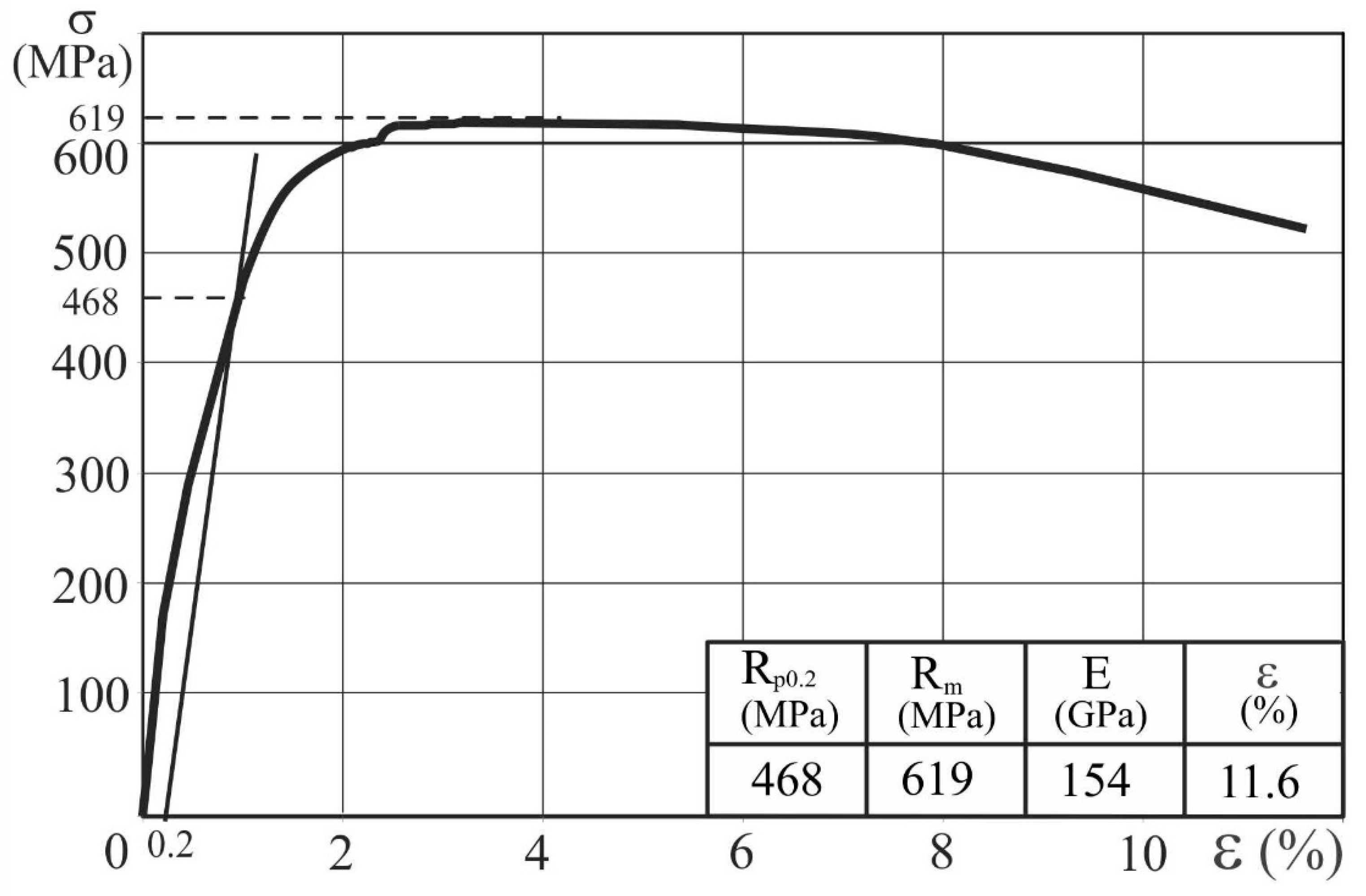


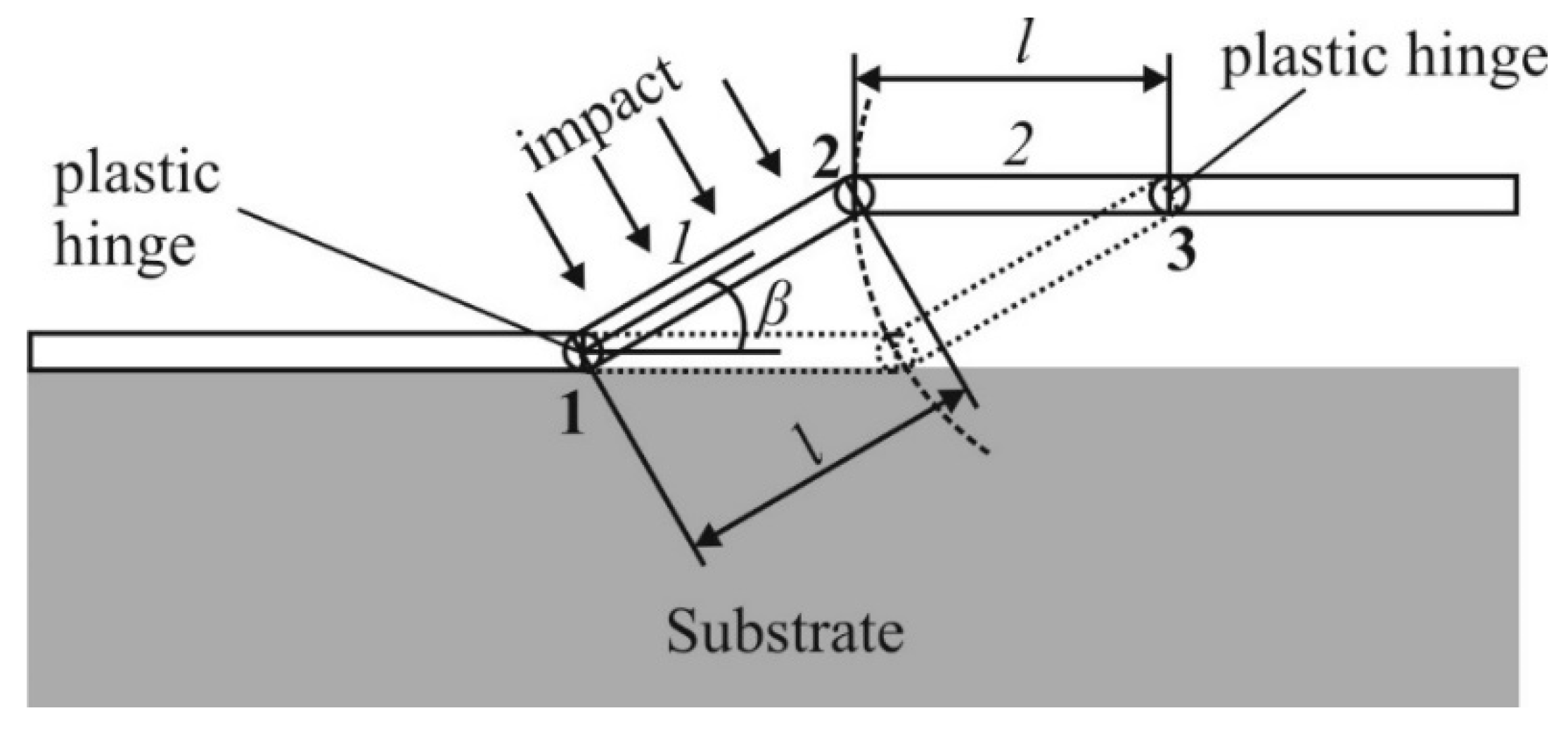



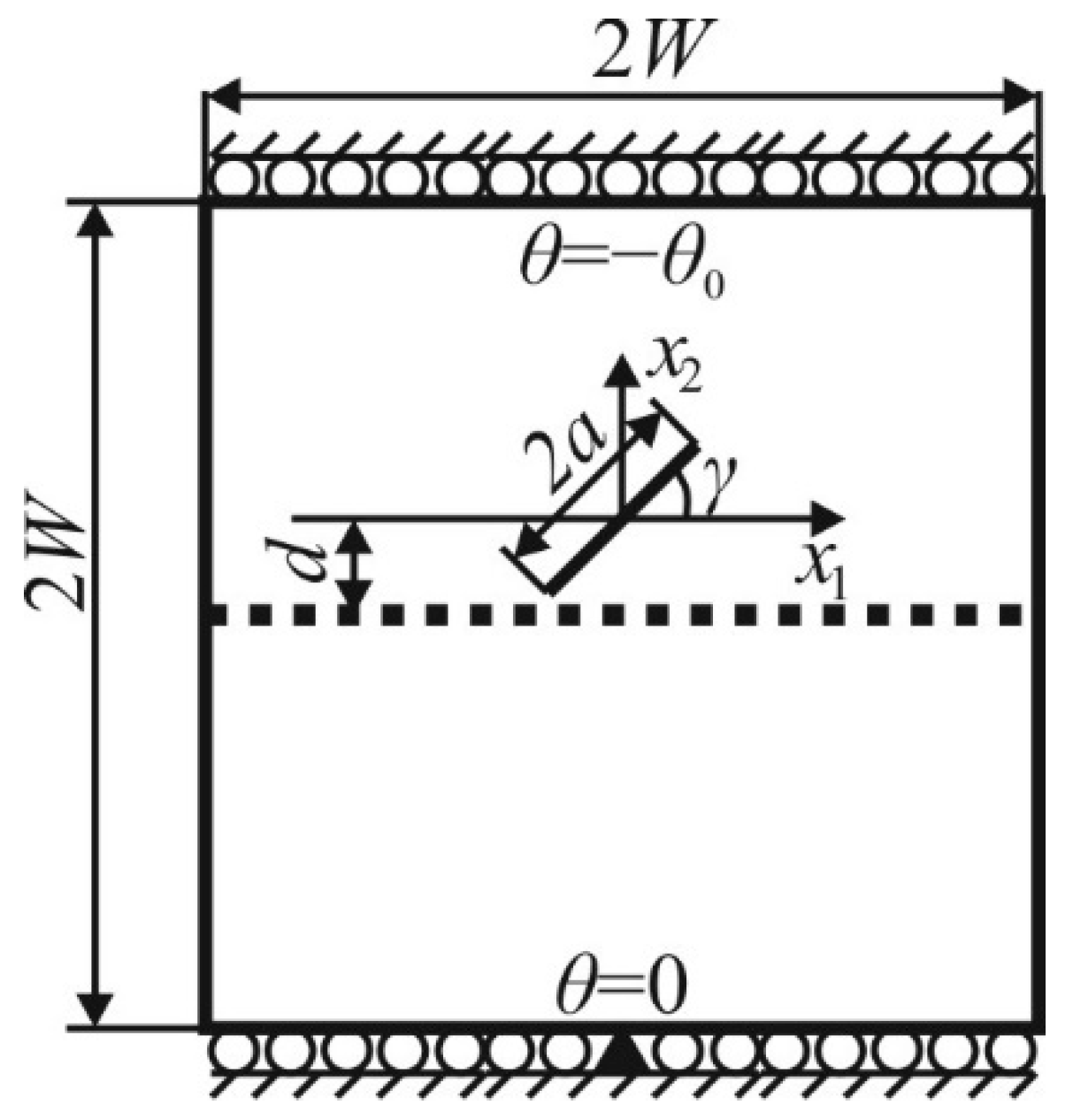
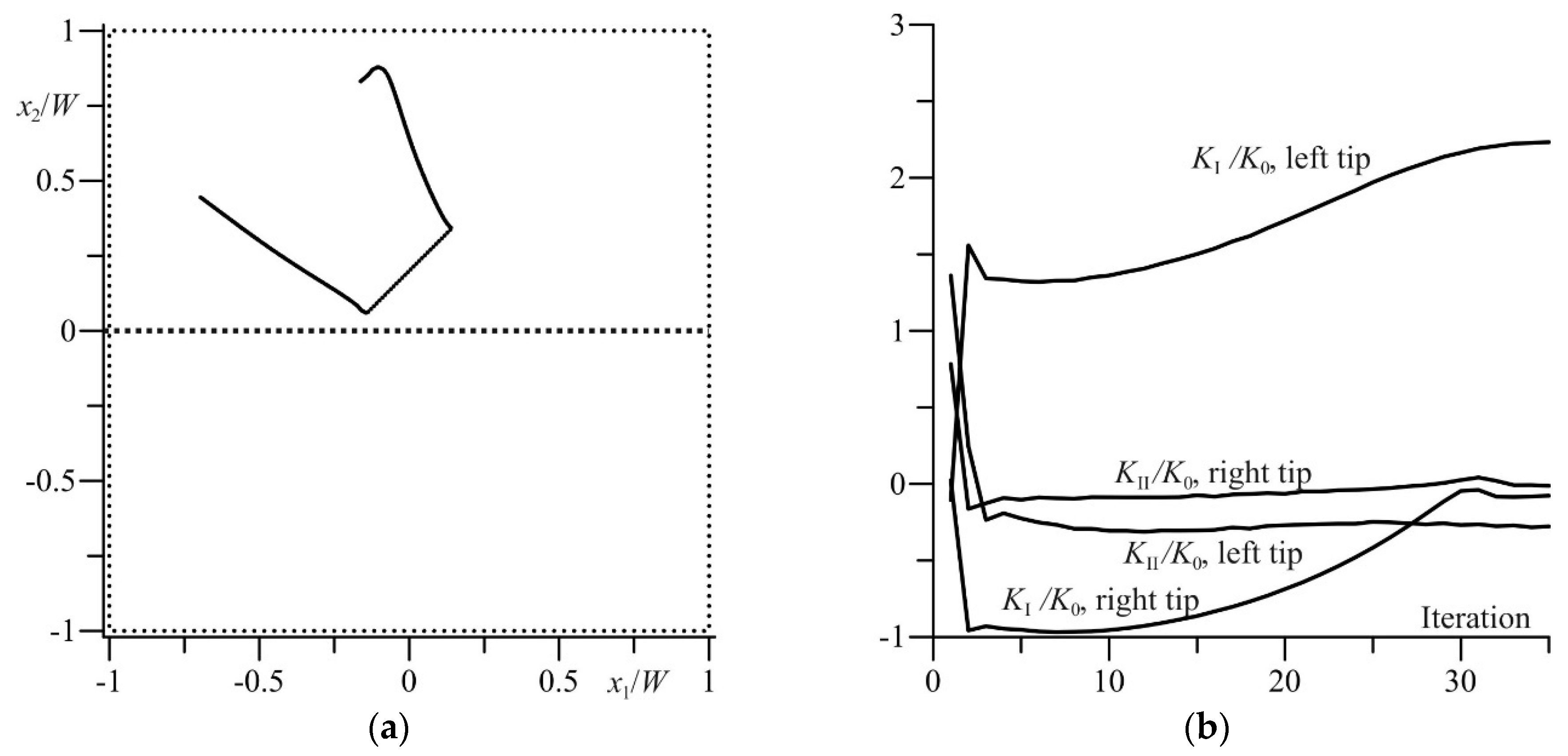
| Chemical Composition (wt %) | ||||||||
|---|---|---|---|---|---|---|---|---|
| Si | Fe | Cu | Mg | Zn | Ti | V | Zr | Sc |
| 0.06 | 0.08 | 5.77 | 0.18 | 0.01 | 0.04 | 0.12 | 0.2 | 0.36 |
| Chemical Composition (wt %) | ||||||
|---|---|---|---|---|---|---|
| O | V | Al | Fe | H | C | N |
| <0.20 | 3.5 | 5.5 | <0.30 | <0.0015 | <0.08 | <0.05 |
| Chemical Composition (wt %) | ||||||
|---|---|---|---|---|---|---|
| Fe | Si | Zn | Mg | Ti | Mn | Cu |
| 0.4% | <0.25 | <0.07 | 0.18 | <0.05 | <0.05 | <0.05 |
© 2019 by the authors. Licensee MDPI, Basel, Switzerland. This article is an open access article distributed under the terms and conditions of the Creative Commons Attribution (CC BY) license (http://creativecommons.org/licenses/by/4.0/).
Share and Cite
Szachogluchowicz, I.; Sniezek, L.; Grzelak, K.; Sulym, H.; Turchyn, I.; Pasternak, I. The Analytical Model of Stress Zone Formation of Ti6Al4V/AA1050/AA2519 Laminate Produced by Explosive Bonding. Metals 2019, 9, 779. https://doi.org/10.3390/met9070779
Szachogluchowicz I, Sniezek L, Grzelak K, Sulym H, Turchyn I, Pasternak I. The Analytical Model of Stress Zone Formation of Ti6Al4V/AA1050/AA2519 Laminate Produced by Explosive Bonding. Metals. 2019; 9(7):779. https://doi.org/10.3390/met9070779
Chicago/Turabian StyleSzachogluchowicz, Ireneusz, Lucjan Sniezek, Krzysztof Grzelak, Heorhiy Sulym, Ihor Turchyn, and Iaroslav Pasternak. 2019. "The Analytical Model of Stress Zone Formation of Ti6Al4V/AA1050/AA2519 Laminate Produced by Explosive Bonding" Metals 9, no. 7: 779. https://doi.org/10.3390/met9070779
APA StyleSzachogluchowicz, I., Sniezek, L., Grzelak, K., Sulym, H., Turchyn, I., & Pasternak, I. (2019). The Analytical Model of Stress Zone Formation of Ti6Al4V/AA1050/AA2519 Laminate Produced by Explosive Bonding. Metals, 9(7), 779. https://doi.org/10.3390/met9070779







